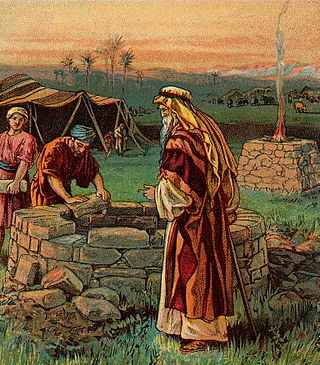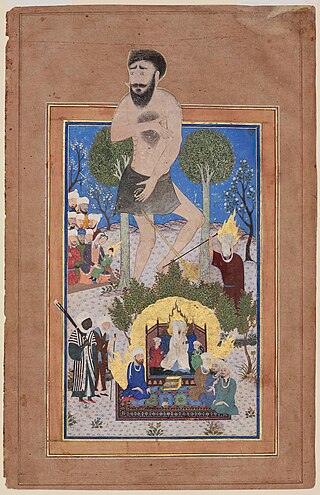Related Research Articles

Isaac is one of the three patriarchs of the Israelites and an important figure in the Abrahamic religions, including Judaism, Christianity, and Islam. He was the son of Abraham and Sarah, the father of Jacob and Esau, and the grandfather of the twelve tribes of Israel.

The Philistines were an ancient people who lived on the south coast of Canaan during the Iron Age, in a confederation of city-states generally referred to as Philistia. The Philistines originated as an immigrant group from the Aegean that settled in Canaan circa 1175 BC, during the Late Bronze Age collapse. Over time, they gradually assimilated elements of the indigenous Semitic Levantine societies while preserving their own unique culture. In 604 BC, the Philistine polity, after having already been subjugated for centuries by the Neo-Assyrian Empire, was finally destroyed by King Nebuchadnezzar II of the Neo-Babylonian Empire. After becoming part of his empire and its successor, the Persian Empire, the Philistines lost their distinct ethnic identity and disappeared as a people from the historical and archaeological record by the late 5th century BC.

Canaan was a Semitic-speaking civilization and region of the Southern Levant in the Ancient Near East during the late 2nd millennium BC. Canaan had significant geopolitical importance in the Late Bronze Age Amarna Period as the area where the spheres of interest of the Egyptian, Hittite, Mitanni, and Assyrian Empires converged or overlapped. Much of present-day knowledge about Canaan stems from archaeological excavation in this area at sites such as Tel Hazor, Tel Megiddo, En Esur, and Gezer.

The Israelites were a group of Semitic-speaking tribes in the ancient Near East who, during the Iron Age, inhabited a part of Canaan.
Anakim are mentioned in the Bible as descendants of Anak.

According to the Hebrew Bible, the Tribe of Ephraim was one of the tribes of Israel. The Tribe of Manasseh together with Ephraim formed the House of Joseph. It is one of the ten lost tribes. The etymology of the name is disputed.

Shechem, also spelled Sichem, was an ancient city in the southern Levant. Mentioned as a Canaanite city in the Amarna Letters, it later appears in the Hebrew Bible as the first capital of the Kingdom of Israel following the split of the United Monarchy. According to Joshua 21:20–21, it was located in the tribal territorial allotment of the tribe of Ephraim. Shechem declined after the fall of the northern Kingdom of Israel. The city later regained its importance as a prominent Samaritan center during the Hellenistic period.

The Horites, were a people mentioned in the Torah inhabiting areas around Mount Seir in Canaan.

Og according to the Hebrew Bible and other sources, was an Amorite king of Bashan who was slain along with his army by Moses and his men at the battle of Edrei. In Arabic literature he is referred to as ʿŪj ibn ʿAnāq.
The Hittites, also spelled Hethites, were a group of people mentioned in the Hebrew Bible. Under the names בני-חת and חתי they are described several times as living in or near Canaan between the time of Abraham and the time of Ezra after the return of the Jews from the Babylonian exile. Their ancestor was Heth.

Lech-Lecha, Lekh-Lekha, or Lech-L'cha is the third weekly Torah portion in the annual Jewish cycle of Torah reading. It constitutes Genesis 12:1–17:27. The parashah tells the stories of God's calling of Abram, Abram's passing off his wife Sarai as his sister, Abram's dividing the land with his nephew Lot, the war between the four kings and the five, the covenant between the pieces, Sarai's tensions with her maid Hagar and Hagar's son Ishmael, and the covenant of circumcision.

The Bible Unearthed: Archaeology's New Vision of Ancient Israel and the Origin of Its Sacred Texts, a book by Israel Finkelstein, Professor of Archaeology at Tel Aviv University, and Neil Asher Silberman, an archaeologist, historian and contributing editor to Archaeology Magazine published in 2001 by Simon & Schuster using its imprint The Free Press and reprinted in 2002 using its Touchstone imprint, discusses the archaeology of Israel and its relationship to the origins and content of the Hebrew Bible.

Toledot, Toldot, Toldos, or Toldoth is the sixth weekly Torah portion in the annual Jewish cycle of Torah reading. The parashah tells of the conflict between Jacob and Esau, Isaac's passing off his wife Rebekah as his sister, and Isaac's blessing of his sons.
The Perizzites are a group of people mentioned many times in the Bible as having lived in the land of Canaan before the arrival of the Israelites. The name may be related to a Hebrew term meaning "rural person."

In the Hebrew Bible, as well as non-Jewish ancient texts from the region, the Northwest Semitic term Rephaite or Repha'im refers either to a people of greater-than-average height and stature in Deuteronomy 2:10-11, or departed spirits in the Jewish afterlife, Sheol as written in the following scriptures: Isaiah 26:14; Psalms 88:11, and Proverbs 9:18, as well as Isaiah 14:9.

Devarim, Dvarim, or Debarim is the 44th weekly Torah portion in the annual Jewish cycle of Torah reading and the first in the Book of Deuteronomy. It comprises Deuteronomy 1:1–3:22. The parashah recounts how Moses appointed chiefs, the episode of the Twelve Spies, encounters with the Edomites and Ammonites, the conquest of Sihon and Og, and the assignment of land for the tribes of Reuben, Gad, and Manasseh.
Phicol, also spelled Phichol (KJV) or Phikol, was a Philistine military leader.

The Amorites were an ancient Northwest Semitic-speaking Bronze Age people from the Levant. Initially appearing in Sumerian records c. 2500 BC, they expanded and ruled most of the Levant, Mesopotamia and parts of Egypt from the 21st century BC to the late 17th century BC.
War in the Hebrew Bible concerns any military engagement narrated or discussed in the Hebrew Bible, also known as the Tanakh or Old Testament of the Bible. Texts about war in the Hebrew Bible are part of the broader topic of The Bible and violence. They cover a wide range of topics from detailed battle reports including weapons and tactics used, numbers of combatants involved, and casualties experienced, to discussions of motives and justifications for war, the sacred and secular aspects of war, descriptions and considerations of what in modern times would be considered war crimes such as genocide or wartime sexual violence, and reflections on wars that have happened, or predictions, visions or imaginations of wars that are yet to come.
References
- ↑ G. Hirsch, Emil; Seligsohn, M. (2021). "GIANTS". Jewish Encyclopedia. Archived from the original on 20 September 2023.
- ↑ (also mentioned in Joshua 13:3–5)
- ↑ D. Rohl, The Lords of Avaris. 2007
![]() This article incorporates text from a publication now in the public domain : Easton, Matthew George (1897). Easton's Bible Dictionary (New and revised ed.). T. Nelson and Sons.
This article incorporates text from a publication now in the public domain : Easton, Matthew George (1897). Easton's Bible Dictionary (New and revised ed.). T. Nelson and Sons.{{cite encyclopedia}}: Missing or empty |title= (help)